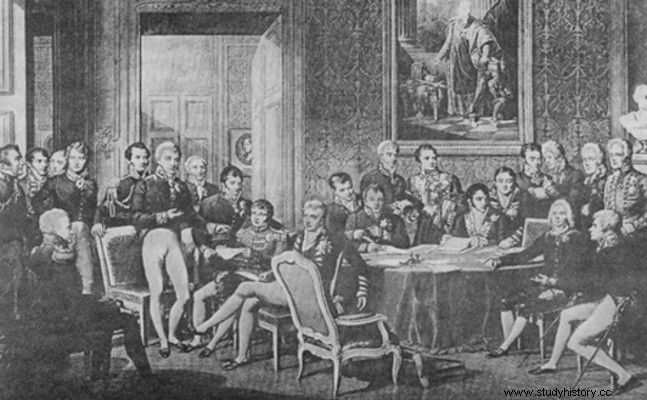
With the abdication of Napoleon Bonaparte in 1814 and the consequent end of the Napoleonic Era , the powers that were involved in the wars waged by the French emperor came together in the capital of Austria, Vienna, to trace the directions that Europe would take from that moment on. This articulation was called Congress from Vienna.
In addition to Austria, which hosted the congress, the other participating powers were France, Prussia, Russia and Great Britain. The representatives who attended the congress were the Austrian prince Klemens Metternich , the French diplomat Charles Talleyrand, Russian Tsar Alexander I , the English Prime Minister Viscount from Castlereagh and Frederico Guilherme III , from Prussia.
The main objective of the Congress of Vienna was to resume the political model that ruled Europe before the Napoleonic wars, that is, it aimed to resume the structures of the Ancien Régime, with repression of liberal ideas and revolutionary manifestations of which France was the main “battle horse”. Matternich, from Austria, advocated the defense of the return of power to the old aristocratic families so that they would safeguard the peace of Europe and prevent the proliferation of revolutionary ideas.
Leaders participating in the Congress of Vienna also proposed the defense of two general principles:the principle da legitimacy and the balance from power. The first determined that the dynasties that held power in the period before the French revolutionary process should reassume their thrones and territories. The second preached that the powers that won the war against France would have the right to territories outside the European continent and could remain with those that already belonged to them by merit for participating in the fight against Napoleon Bonaparte. Among the countries that articulated at the Congress of Vienna, England was the one that benefited the most in the long term, as it managed to guarantee military and commercial hegemony in the oceans, in addition to great political and economic influence on the continent.
However, this return to the old order that characterized the proposals of the victorious powers also implied a redefinition of the geopolitical map of Europe, which had been profoundly affected by the Napoleonic empire. To this end, the Russian Tsar, Alexander I, proposed the creation of an alliance. Formed by Russia, Prussia and Austria, the Holy Alliance , as it became known, aimed to guarantee the hegemony of these three countries, as well as to combat outbreaks of revolutions driven by liberal ideas. The first article of the Holy Alliance can be read below:
Art. 1st In accordance with the words of the Holy Scriptures which command all men to regard each other as brothers, the three contracting monarchs will remain united by the bonds of a true and indissoluble fraternity and, considering themselves as compatriots, will lend themselves, on any occasion or place, assistance, help and succor; judging themselves, in relation to their subjects and armies, as fathers of families, they will lead them in the same spirit of brotherhood in which they are animated to protect religion, peace, and justice. (“Treaty of the Holy Alliance”. Trans. Luiz Arnault. Dep. Contemporary History. UFMG.)
_______________
* Image credits:Shutterstock and Neveshkin Nikolay
By me. Claudio Fernandes
